Amazon is surely the first ecommerce retailer that comes into our mind when we think of price dynamism worldwide.
When we take a look at our own database for all the Amazon product prices we are monitoring with Prisync (for the US, Canada, India and also European sites), we see that Amazon changes prices for about 15-20% of its whole assortment on a daily basis.
Currently, hundreds of ecommerce companies across Europe utilise dynamic pricing and they surely regard Amazon as a major competitor due this apparent nature of the retail giant. However, Amazon is not necessarily the only retail giant in every European country out there, and in some of those countries, there are even more active competitors than Amazon to take into account while applying competitive strategies. – in some countries Amazon does not even impose any direct competitive force as it lacks local operations in those specific countries.
Seeing that many of our European customers actually regard major local sites other than Amazon as their biggest competitors, we decided to conduct a similar price dynamism analysis for those sites to put them in perspective vs. Amazon. We listed down the European ecommerce sites that are most commonly regarded as a competitor by our customers from the region, and tried to filter them down by making sure that they are also running a similar ecommerce business model to Amazon, i.e. acts as a major marketplace in the given country.
This analysis then yielded 11 major ecommerce marketplaces from 11 different European countries, and as expected, these websites were not short of price dynamism when compared to Amazon, as they naturally act as the Amazon’s of their countries and probably follow the strategic steps of their role-model.
Before diving into the data that Prisync generated for this analysis, let us share how exactly we collected our data, to give you, our readers, the chance to evaluate the significance of our analysis yourself.
Methodology
Initially, as stated above, we identified the websites on which, we’d apply our price dynamism analysis in comparison to Amazon.
This list (including 11 major ecommerce sites from the European ecommerce market) has been generated from our very own database, already covering fresh and live price points from more than 40 ecommerce markets worldwide.
We identified the following websites as the key market players that are most commonly regarded as the biggest competitor of our customers in the particular country:
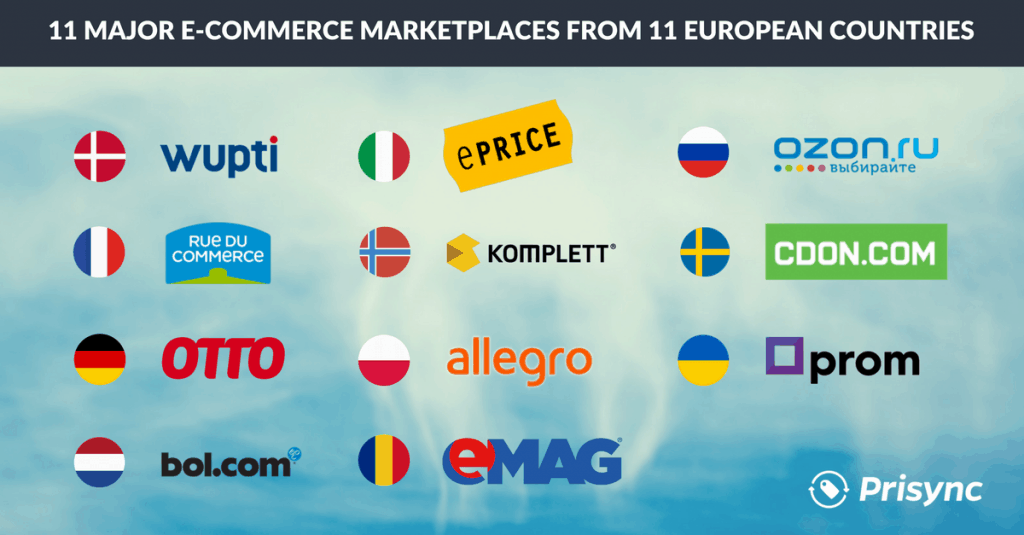
Then, we picked price history snapshots from all these webshops alongside all Amazon products that Prisync monitors (as stated above, not just European, but also US, Canada and Indian sites) for a full 7 days week. We made sure that these assortments cover all the main product categories listed on the website.
Upon applying that filter on the ecommerce sites to standardise the data to be able to apply comparative analysis later on, we calculated the total number of daily price changes for the given assortment throughout the 7 days for each of the websites, and took the average price change count per day as a percentage of the full assortment.
For example, if we detected 490 price changes for a website throughout the week for 1000 products, we’d conclude that the daily price changes were 70 for 1000 products, so we’d conclude that these website was changing prices on a daily basis for about the 7% of its full assortment, in comparison vs. Amazon’s 16% recorded within the same week:
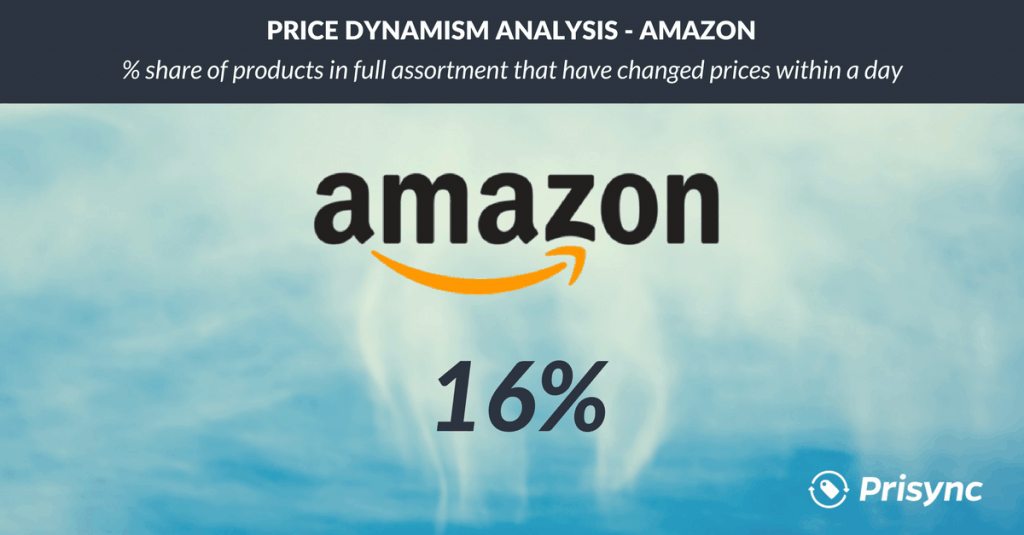
The data that we looked into certainly sparked many other analysis ideas in our minds, but for this post, we sticked with the comparative price dynamism analysis, and you can be sure that it’ll be followed by several other analysis where we’d compare the days of the week in terms of price change counts, or product categories and many other parameters involved in Prisync’s massive database.
With this methodology in hand and applied on the data, let us reveal our raw data for each of the ecommerce sites and our findings for the 11 major European ecommerce sites in terms of price dynamism.
Price Dynamism of wupti.dk – DENMARK
We monitored prices for 1120 randomly picked (as part of the standard process) products from all available categories within the assortment (another part of the standard process) of wupti.dk.
Within the 7 days period of our analysis, Prisync detected daily price changes for a total of 602 products.
To come up with an average number, as explained in the methodology section, we take 602/7= 86 as the estimated product count out of 1120 products monitored, with a daily price change instance.
Therefore, to define the price dynamism, we conclude that 86/1120= 7,6% of the products within full assortment of wupti.dk change prices on a daily basis.
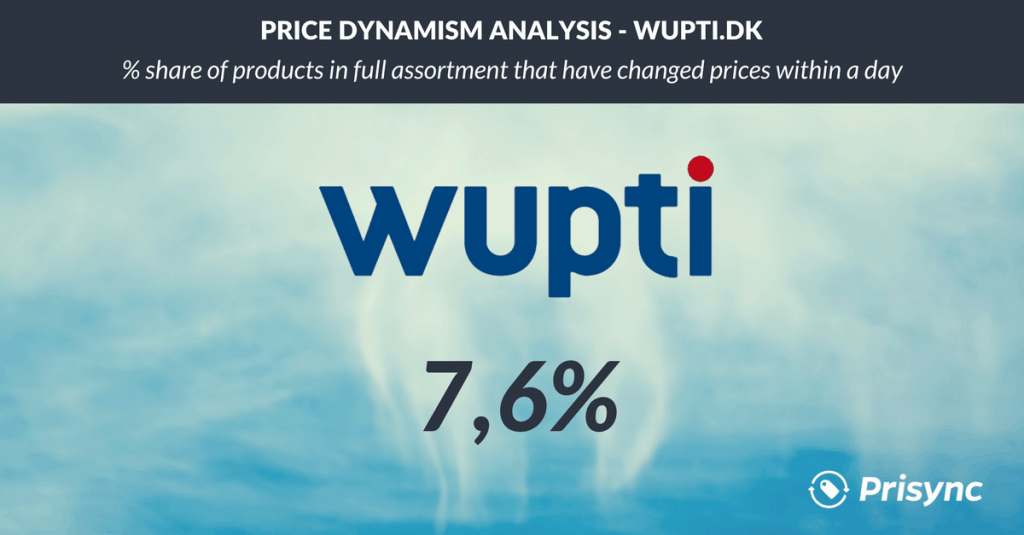
Price Dynamism of rueducommerce.fr – FRANCE
We monitored prices for 3313 randomly picked products from all available categories within the assortment of rueducommerce.fr.
Within the 7 days period of our analysis, Prisync detected daily price changes for a total of 7070 products.
To come up with an average number, as explained in the methodology section, we take 7070/7= 1010 as the estimated product count out of 3313 products monitored, with a daily price change instance.
Therefore, to define the price dynamism, we conclude that 1010/3313= 30,4% of the products within full assortment of rueducommerce.fr change prices on a daily basis.
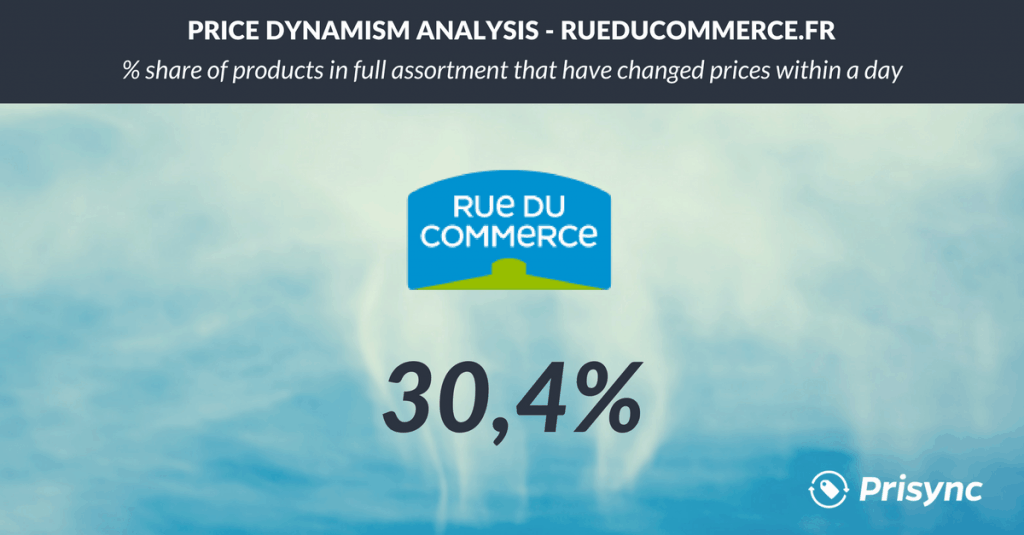
Price Dynamism of otto.de – GERMANY
We monitored prices for 4382 randomly picked products from all available categories within the assortment of otto.de.
Within the 7 days period of our analysis, Prisync detected daily price changes for a total of 2870 products.
To come up with an average number, as explained in the methodology section, we take 2870/7= 410 as the estimated product count out of 4382 products monitored, with a daily price change instance.
Therefore, to define the price dynamism, we conclude that 410/4382= 9,3% of the products within full assortment of otto.de change prices on a daily basis.
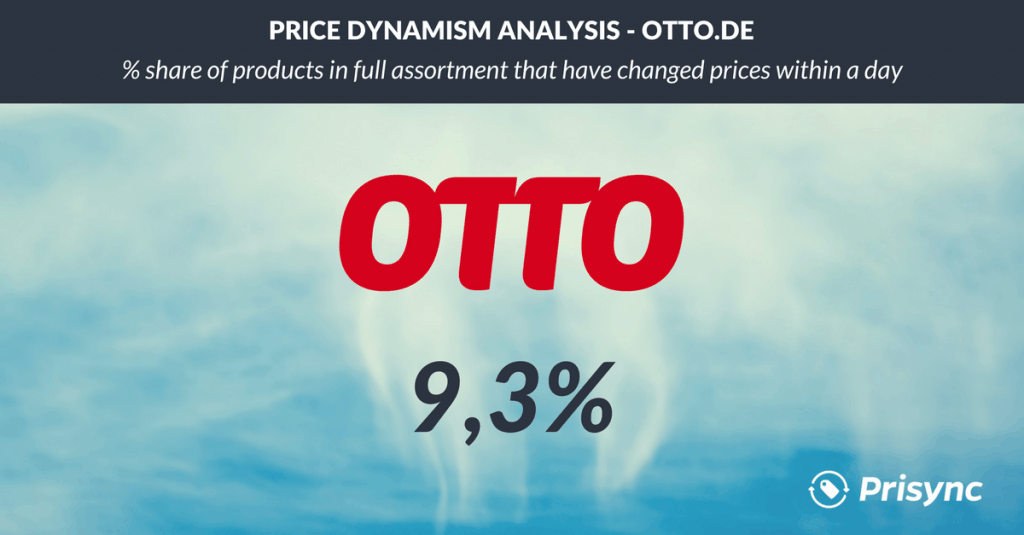
Price Dynamism of bol.com – HOLLAND
We monitored prices for 5000 randomly picked products from all available categories within the assortment of bol.com.
Within the 7 days period of our analysis, Prisync detected daily price changes for a total of 3774 products.
To come up with an average number, as explained in the methodology section, we take 3774/7= 539 as the estimated product count out of 5000 products monitored, with a daily price change instance.
Therefore, to define the price dynamism, we conclude that 539/5000= 10,7% of the products within full assortment of bol.com change prices on a daily basis.
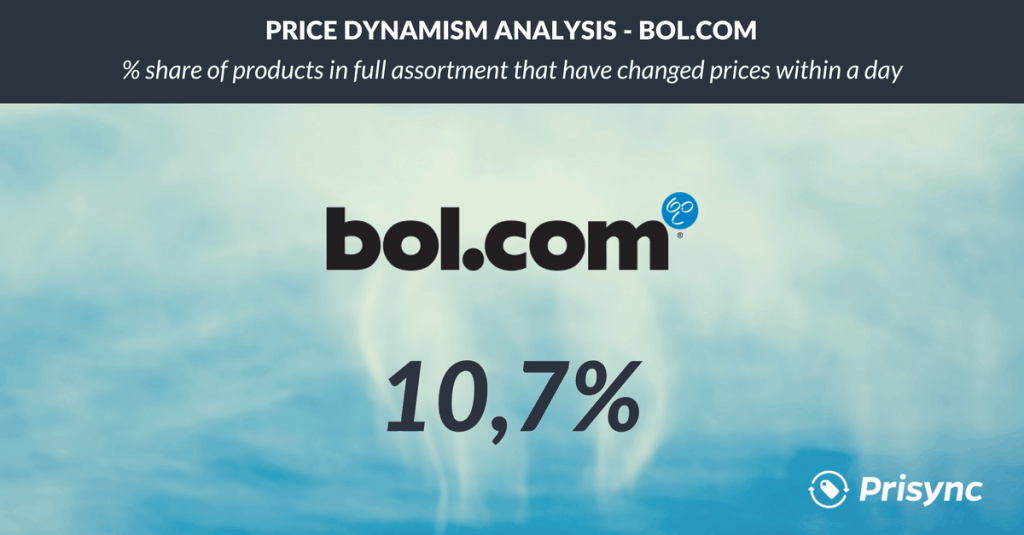
Price Dynamism of eprice.it – ITALY
We monitored prices for 2966 randomly picked products from all available categories within the assortment of eprice.it.
Within the 7 days period of our analysis, Prisync detected daily price changes for a total of 4985 products.
To come up with an average number, as explained in the methodology section, we take 4985/7= 712 as the estimated product count out of 2966 products monitored, with a daily price change instance.
Therefore, to define the price dynamism, we conclude that 712/2966= 24% of the products within full assortment of eprice.it change prices on a daily basis.
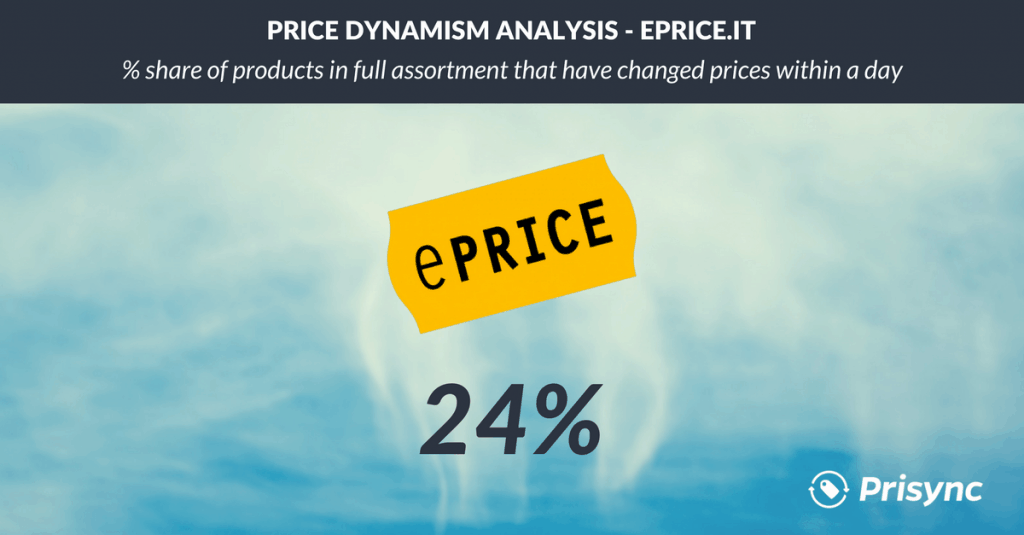
Price Dynamism of komplett.no – NORWAY
We monitored prices for 1297 randomly picked products from all available categories within the assortment of komplett.no.
Within the 7 days period of our analysis, Prisync detected daily price changes for a total of 126 products.
To come up with an average number, as explained in the methodology section, we take 126/7= 18 as the estimated product count out of 1297 products monitored, with a daily price change instance.
Therefore, to define the price dynamism, we conclude that 18/1297= 1,3% of the products within full assortment of komplett.no change prices on a daily basis.
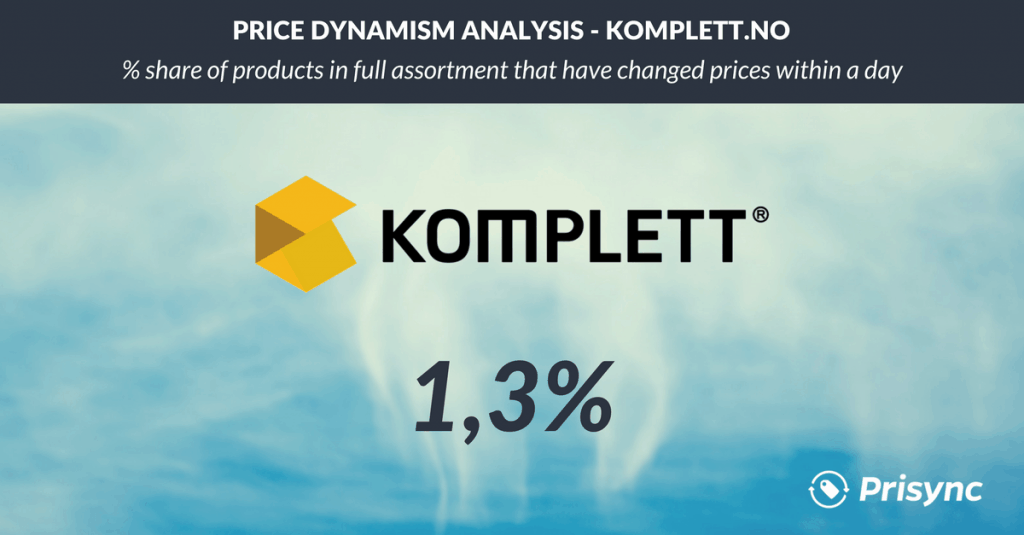
Price Dynamism of allegro.pl – POLAND
We monitored prices for 1469 randomly picked products from all available categories within the assortment of allegro.pl.
Within the 7 days period of our analysis, Prisync detected daily price changes for a total of 932 products.
To come up with an average number, as explained in the methodology section, we take 932/7= 133 as the estimated product count out of 1469 products monitored, with a daily price change instance.
Therefore, to define the price dynamism, we conclude that 133/1469= 9% of the products within full assortment of allegro.pl change prices on a daily basis.
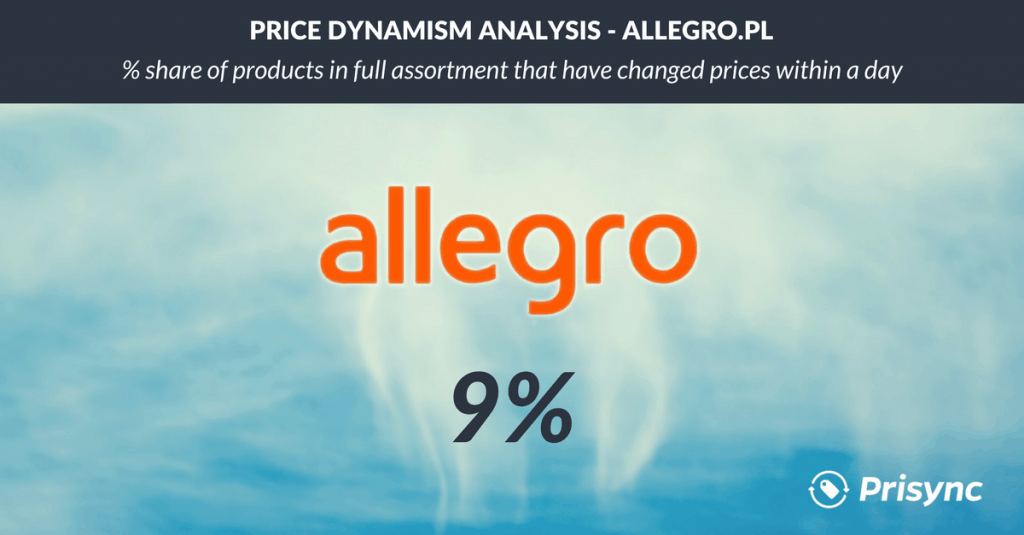
Price Dynamism of emag.ro – ROMANIA
We monitored prices for 1900 randomly picked products from all available categories within the assortment of emag.ro.
Within the 7 days period of our analysis, Prisync detected daily price changes for a total of 345 products.
To come up with an average number, as explained in the methodology section, we take 345/7= 49 as the estimated product count out of 1900 products monitored, with a daily price change instance.
Therefore, to define the price dynamism, we conclude that 49/1900= 2,5% of the products within full assortment of emag.ro change prices on a daily basis.
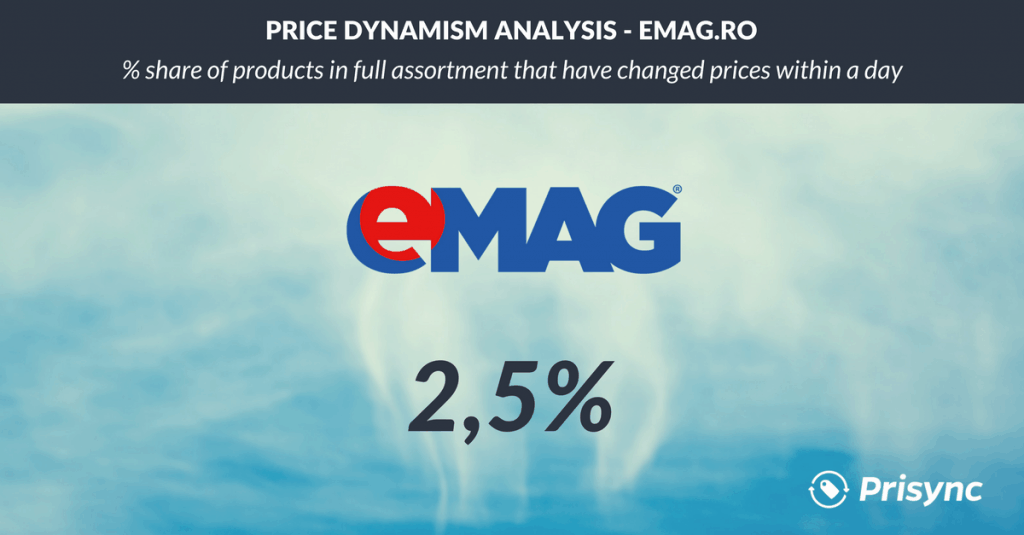
Price Dynamism of ozon.ru – RUSSIA
We monitored prices for 1619 randomly picked products from all available categories within the assortment of ozon.ru.
Within the 7 days period of our analysis, Prisync detected daily price changes for a total of 2935 products.
To come up with an average number, as explained in the methodology section, we take 2935/7= 419 as the estimated product count out of 1619 products monitored, with a daily price change instance.
Therefore, to define the price dynamism, we conclude that 419/1619= 25,8% of the products within full assortment of ozon.ru change prices on a daily basis.
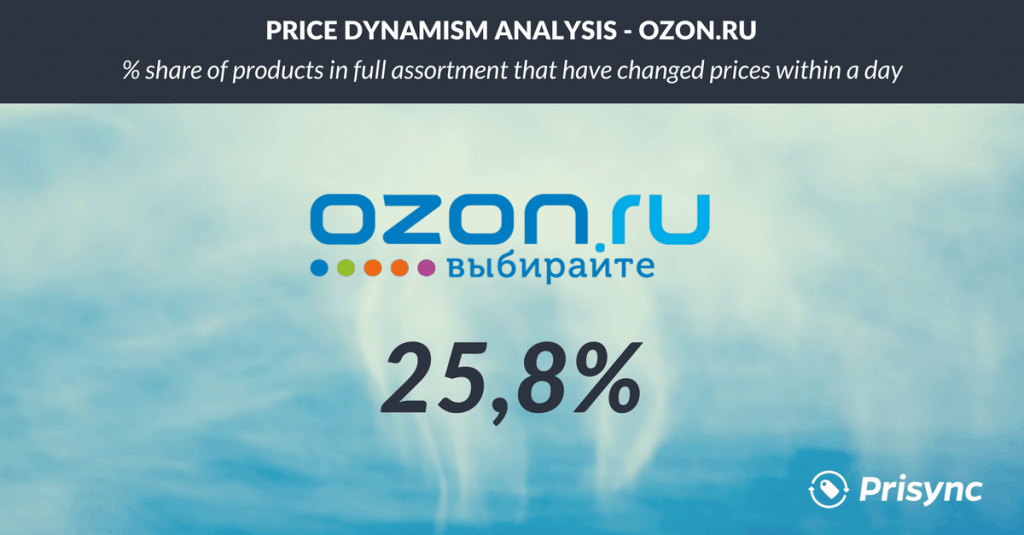
Price Dynamism of cdon.se – SWEDEN
We monitored prices for 661 randomly picked products from all available categories within the assortment of cdon.se.
Within the 7 days period of our analysis, Prisync detected daily price changes for a total of 239 products.
To come up with an average number, as explained in the methodology section, we take 239/7= 34 as the estimated product count out of 661 products monitored, with a daily price change instance.
Therefore, to define the price dynamism, we conclude that 34/661= 5,1% of the products within full assortment of cdon.se change prices on a daily basis.
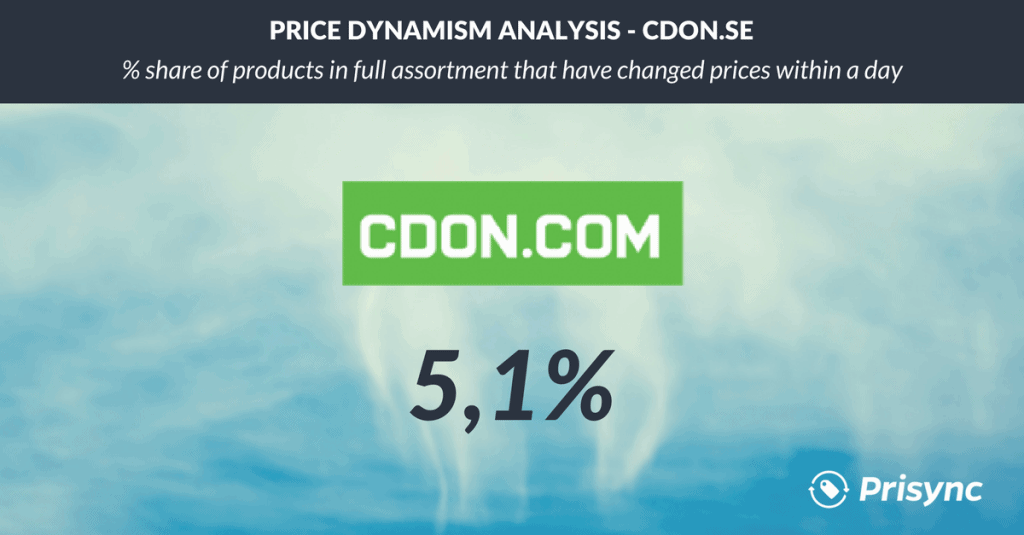
Price Dynamism of prom.ua – UKRAINE
We monitored prices for 3780 randomly picked products from all available categories within the assortment of prom.ua.
Within the 7 days period of our analysis, Prisync detected daily price changes for a total of 1227 products.
To come up with an average number, as explained in the methodology section, we take 1227/7= 175 as the estimated product count out of 3780 products monitored, with a daily price change instance.
Therefore, to define the price dynamism, we conclude that 175/3780= 4,6% of the products within full assortment of prom.ua change prices on a daily basis.
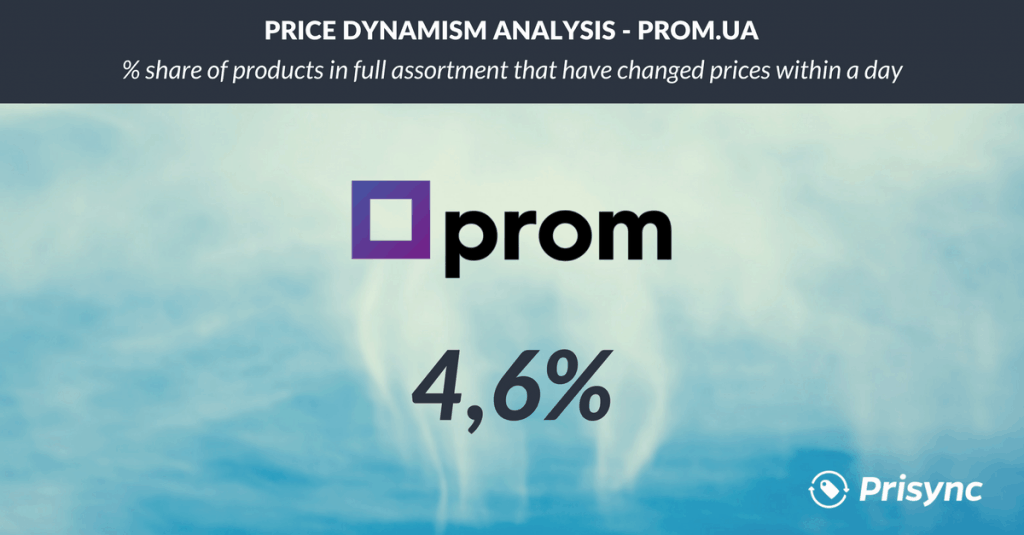
Conclusion and further study planned
The data that we see here, probably triggers more questions than it answers, and we’ll come to that point as we’ll clearly define what we have in mind as the later steps of this analysis as further study at the very end of this article.
As you can see from the data given above, the price dynamism of the ecommerce sites being analysed has a somewhat huge variance. With all the statistical limitations (more on this below) taken into account, we can see that some of the major European ecommerce marketplaces are even more dynamic in prices when compared to Amazon (which has the 16% ratio).
Here’s how the full comparison of price dynamism look when we also add Amazon into the picture:
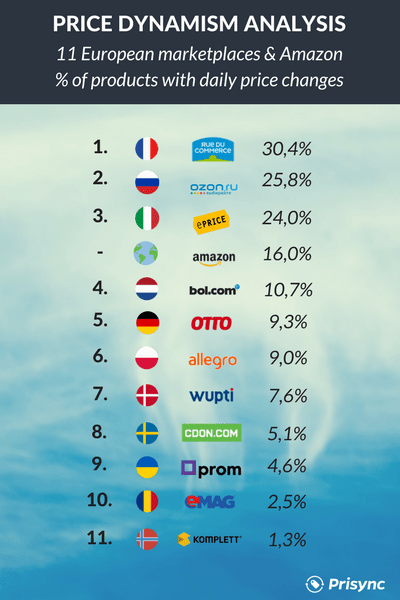
With the exception of ozon.ru and Russia, we may say that the marketplaces which also competes with Amazon in their country (Rueducommerce.fr vs. Amazon.fr, Eprice.it vs. Amazon.it) kind of gained the same capabilities of their giant competitors when it comes to price dynamism, and they have even surpassed Amazon.
The ones that are less dynamic than Amazon can also be clustered in two batches. In the first batch, we have bol.com, otto.de, allegro.pl and wupti.dk, where 7-10% of products change prices on a daily basis. And the secondary batch contains cdon.se, prom.ua, emag.ro and komplett.no, where this ratio is less than 5% on average.
First of all, let me emphasise once again that, this comparative price dynamism analysis is an attempt with a certain methodology and its statistical significance. The significance of the data can surely be improved and idealised by increasing the product count being monitored in this analysis.
With that in mind, we believe, data still carries meaningful messages for ecommerce companies active in these countries and consider the listed ecommerce marketplaces as their competitors.
As stated above, this piece of work can be extended in numerous ways.
First of all, throughout 2018, we, as Prisync, aim to extend our coverage of websites included in this analysis (as Prisync already helps companies from more than 40 countries) and we hope to derive other findings from our dataset, like the correlation between price changes and the day of the week or the time of the day. We also hope to come up with comparative analysis vs. countries rather than just their major ecommerce marketplaces.
Wrapping up the price changes in the European market
In short, we regard this comparative analysis as one of the early steps into our data analysis journey which heavily and thankfully relies on the massive amount of fresh online pricing data from the global ecommerce market populated by our pricing software.
Please shoot over your comments or questions at the comment box below, and for any of your inquiries regarding the methodology, raw data or the tools used in this analysis, shoot me an email at burc[at]prisync[dot]com.
pricing strategies


Quelle meilleure fa?on de prouver que les sceptiques avaient tort de mettre fin à la sécheresse titre Knicks, qui remonte à 1973?